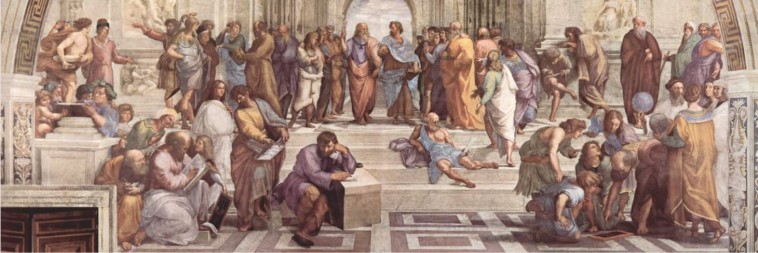Hypatia of Alexandria, from genius to martyr

Hypatia of Alexandria is considered the first woman scientist for whose work has well-documented historical confirmation. Astronomer, mathematician, philosopher, she was distinguished by unusual intelligence, wisdom, eloquence – and beauty.
She lived in the 4th and the beginning of the 5th century AD, in a dark time of turmoil of civilizations. That was the time when ancient civilization was disappearing before the coming influence of Christianity, the time of the struggle between a dogmatic religious view of the world and a free-spirited way of thinking, characteristic of “pagan” ancient philosophy.
That conflict led to the sad end of Hypatia of Alexandria, “the most famous woman of her time”, as many called her. While the year of her birth is not known for sure, it is known that she was brutally murdered, and then burned by Christian mobs in 415 AD.
It is believed that Cyril, who was the bishop of Alexandria at the time, was largely responsible for this brutal act.
Hypatia’s unusual life and tragic death caused a legend to be created around her, which inspired many artists, both painters and writers, until today.
Where she lived and worked
Hypatia was born, lived, and died in Alexandria, which in her time was not only the capital of Egypt, but also the spiritual center of that part of the world.
Since it was founded (332 BC) by Alexander, it constantly developed and grew under the rule of the Greek pharaohs of Egypt of the Ptolemaic dynasty. Its rich trading port was famous for its Pharos lighthouse, one of the seven wonders of the ancient world.
No less famous was the famous Library of Alexandria, with its huge collection of books. A Museum was built next to the library, with its halls, laboratories, observatories, and even zoos. It was an ancient university and scientific research center.

Almost at the same time, Eratosthenes lived, who was the first to measure the circumference of the Earth. The geographer, who was after Hipparchus and the greatest ancient astronomer, was Claudius Ptolomey, who also lived in Alexandria and after whom the geocentric Ptolemaic model of the cosmos was named.
His works Syntaxis and Tables were important subjects of Hypatia’s study. Diophantus of Alexandria was the author of the famous work Arithmetica, also very relevant to Hypatia’s work. Finally, the professor at the Museum was Theon of Alexandria, mathematician and astronomer, Hypatia’s father.
Hypatia’s life and death
Only in such an environment as it was in Alexandria at that time could a well-educated, intelligent and wise personality like Hypatia emerge.
Her father Theon, wanting to form his daughter as a “perfect human being”, gave her a very versatile education, not only in science, but also philosophy, and even sports. She collaborated with her father in scientific work, and many believe that she surpassed him.
She started teaching mathematics, astronomy, and philosophy very early. She gave public lectures to all those who were interested in the teachings of Aristotle, Plato and the Neoplatonists. Later, around 400 AD, we find her at the head of the Alexandrian school of Neoplatonism.

The most famous of her students is Synesius of Cyrene, a Christian, later bishop of Ptolomais, whose letters to Hypatia are an important source of information about her work.
Hypatia advocated the ideas of rationality, tolerance and reason. Her loveliness, intelligence and wisdom made her adored throughout the city and respected by the Alexandrian magistrates.
In particular, she maintained friendly relations with the Alexandrian prefect Orestes.
Such a “pagan” Hypatia causes not only the envy and hatred of the Alexandrian bishop Cyril, but also the fear that her reputation and talent will lead to the dangerous prestige of paganism over Christianity.
This church dignitary was known for his religious intolerance and persecution of heterodox Christian groups and Jews. He was no stranger to meddling in civil affairs – he came into a big conflict with Prefect Orestes.
Hypatia, an easier target for Cyril’s revenge than Orestes, who was protected by the state hierarchy, was accused of escalating the conflict.
In order to denigrate the image of Hypatia among the lowest layers of society, the prevailing prejudice of the time was used that “mathematicians” (which included astronomers and astrologers), scientists and charlatans, without distinction, practice black magic and witchcraft, especially women!
In the year 415, a Christian mob dragged Hypatia out of her chariot on her way back from the city, dragged her to the Caesareum church, stripped her naked and painfully slaughtered her using pottery shards.
This cruel act remained in the minds of the citizens of Alexandria for a long time. However, Cyril managed to avoid any responsibility, and was even later declared a saint.
Hypatia’s intellectual legacy
It is known from ancient sources that Hypatia was primarily engaged in philosophy. This was the philosophy of Neoplatonism, which dealt with the “secret of existence”, observing reality until one reaches elevated states of consciousness and “unity with the divine”, the One.
This philosophy is closely related to Mathematics. Thus Geometry, even if it has its origin in the practical world of measurement, goes beyond that beginning and works in the world of ideas: Mathematics is the paradigm of the transcendence of the material, from which Neoplatonism begins.
It is interesting that not a single philosophical writing of Hypatia has been found to date. As for papers in science (primarily mathematics and astronomy), there is much more data. It is considered that she independently wrote three books, the titles of which are explicitly stated, even though the texts of these works have not been preserved.
In addition, in collaboration with her father Theon of Alexandria, she edited Ptolemy’s Almagest. It is one of the most influential works in the history of science, which has been the basic textbook of astronomy for over a thousand years.
Studying Hypatia’s life and work, we come to the conclusion, unfortunately, that no matter how large her entire oeuvre was, only a small part has reached us, and mostly not in its original form. What we know for sure is that she was her father’s true daughter.
Like him, she was dedicated to preserving the intellectual heritage of the Alexandrian scientists, publishing, commenting on and teaching the works of classical authors, with the fact that she extended this program to include newer, less studied authors. There is no record of research work in mathematics, both for Hypatia and for her father.
In addition to mathematics, Hypatia dealt with science in a broader sense; in addition to astronomy, there are also scientific instruments based on the mathematical principles she taught. Both from ancient and more recent sources, the image of Hypatia emerges as an outstanding, versatile pedagogue, who surpassed her father in this regard.
We have seen that her interest included not only the entire science of her age, but also speculative philosophy. The “sacred” sciences, such as mathematics and astronomy, were important as a path to the One, whose emanations are Spirit and Intellect. This Neoplatonist understanding is not far from the Christian idea of the holy trinity, a concept elaborated as a Christian by Hypatia’s disciple Synesius.

Dedicated work on the preservation and transmission of knowledge was Hypatia’s primary task. This was a response – and a very brave one at that – to the challenges of the difficult times in which she lived. Although much information about her and her work has been lost forever, what we do know is more than enough to cause great admiration.
The legend of Hypatia and the ideals she represented could not be destroyed so easily. Even in medieval Byzantium, Hypatia was a model of an educated woman, and since the Renaissance she has been celebrated in numerous novels, poems and other works of art.
- Her glory has not been eclipsed even to this day: Hypatia lives forever, sitting serenely on the moon, by the shores of the Sinus Asperitatis, between the Sea of Tranquility and the Sea of Nectar.
- About 100 km south of the place where the first man set foot on the moon’s surface – it was Neil Armstrong, on the Apollo 11 mission in 1969 – there are two characteristic structures that bear the name Hypatia: an irregular crater and a system of grooves.
- Another astronomical object bears Hypatia’s name: 238 Hypatia is a very large asteroid, found by the Russian astronomer Viktor Knorr in 1884 in Berlin. According to its spectrum, it is classified as a C-type asteroid, probably composed of carbonaceous material.

